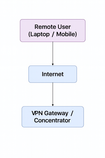Understanding WAN Technologies: Fiber, SDH, and SONET
- The Itvue Team
- Aug 21
- 2 min read
Author Ermias Teffera
At ITVue Networks, building high-performance, reliable wide area networks (WANs) is essential for enterprises and service providers. WAN technologies like Fiber, SDH (Synchronous Digital Hierarchy), and SONET (Synchronous Optical Network) form the backbone of modern global networks. This blog explores these technologies, their principles, benefits, and real-world applications.
1. Fiber Optic Networks
Fiber optic cables transmit data as light pulses over glass or plastic fibers. They are widely used for WAN links because of their high bandwidth, low latency, and long-distance capabilities.
Key Features:
High-speed data transmission (up to 400 Gbps and beyond)
Long-distance reach without signal degradation
Immunity to electromagnetic interference (EMI)
Supports point-to-point, ring, and mesh topologies
Figure-8 Fiber Topology
One common WAN design is a figure-8 topology, which provides redundancy and loop protection. If one path fails, traffic can reroute along the other path.

2. SDH (Synchronous Digital Hierarchy)
SDH is a standardized multiplexing protocol used to transfer multiple digital bit streams over optical fiber. It’s widely used in Europe and internationally for high-speed backbone WANs.
Key Features:
Hierarchical structure: STM-1, STM-4, STM-16, STM-64 (each higher level multiplies the base bandwidth)
High reliability and low latency
Simplifies network management with structured channels
SDH Benefits:
Efficient multiplexing of voice, data, and video
Easy monitoring and fault detection
Flexible bandwidth provisioning
3. SONET (Synchronous Optical Network)
SONET is the North American equivalent of SDH. It provides a synchronous, optical-based WAN protocol for high-speed transmission.
Key Features:
Standardized framing: STS-1, STS-3, STS-12
Supports ring, point-to-point, and mesh topologies
Fast fault detection and automatic protection switching
SONET Figure-8 Topology
A typical WAN uses a dual-ring figure-8 topology, ensuring that even if one fiber link fails, traffic can reroute via the secondary ring.

4. Comparing Fiber, SDH, and SONET
Feature | Fiber | SDH | SONET |
Medium | Optical fiber | Optical fiber | Optical fiber |
Standardization | IEEE standards | ITU-T SDH | ANSI SONET |
Topology | Point-to-point, ring, mesh | Ring, point-to-point | Ring, point-to-point |
Bandwidth | Up to 400 Gbps+ | STM-1 to STM-64 | STS-1 to STS-192 |
Fault Tolerance | Depends on topology | Built-in with rings | Built-in with rings |
5. Real-World Application
Enterprise WANs: Fiber for high-speed connections between headquarters and branches.
ISP Backbone: SDH or SONET provides structured, high-bandwidth optical links for carrier-grade reliability.
Redundant Connectivity: Figure-8 rings allow automatic failover in case of fiber cuts.
6. Best Practices
Use dual-ring figure-8 topology for mission-critical WAN links.
Choose SDH/SONET for legacy backbone integration and multi-service transport.
Deploy high-speed fiber for modern WANs with growing bandwidth needs.
Monitor network performance using optical and SONET/SDH management tools.
Conclusion
Fiber, SDH, and SONET are the backbones of WAN connectivity, each providing unique advantages for scalability, redundancy, and high-speed data transmission. By combining figure-8 topologies, ring architectures, and optical fiber links, ITVue Networks ensures resilient, high-performance WAN infrastructures for enterprise and service provider environments.










Comments